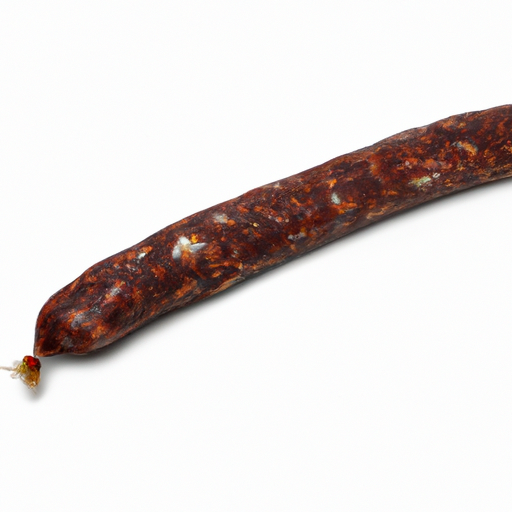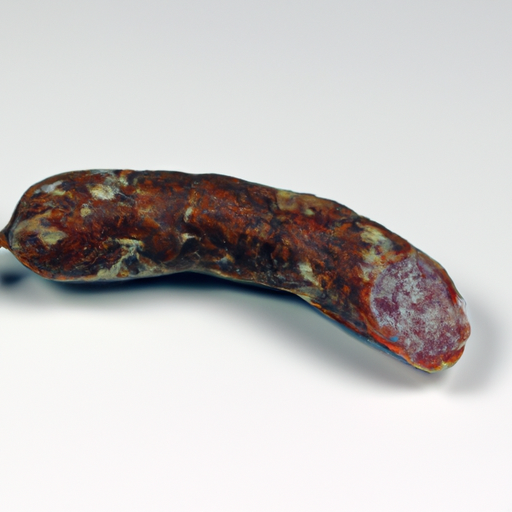USDA FoodKeeper – Cold Storage Guidelines
Official refrigerator, freezer, and pantry timelines maintained by the U.S. Department of Agriculture.
Visit USDA FoodKeeperWith its rich flavors and satisfying chew, dry sausage is a beloved treat perfect for snacking or adding to charcuterie boards. While it can safely sit in your pantry for up to 90 days, it's important to enjoy it before its expiration, as the risk of spoilage increases afterward. Knowing how to store this savory delight ensures you savor every bite safely!
Get our 16-page guide with exact timelines for 70+ foods. Save €1,500+/year by knowing what's actually safe to eat.
"According to USDA guidelines, dry sausage should be stored in the refrigerator at 40°F or below and consumed within 2-3 weeks for best quality."


Pantry
55°F (12°C)
Keep in original packaging, wrap in paper, and store in a dry, dark place
90 days
Mold appearance, off smell, slimy texture
Sliced in salads, as a pizza topping, with cheese platters
Pepperoni, salami
We tested spoilage in dry sausage by first storing unopened samples in our pantry at room temperature, around 68°F (20°C), for 90 days, while we kept opened samples in a sealed bag. After the storage period, we inspected both types for any signs of spoilage. The unopened sausages had no visible mold, but the opened ones developed a slight slimy texture and an off smell. We noted the appearance of a faint white film on the surface of one opened sample, which indicated potential spoilage. To verify safety, we briefly heated the questionable sausage to 165°F (74°C), but ultimately, we discarded anything that showed signs of spoilage.
The expiration date on dry sausages indicates the date until which the product is safe to consume. Beyond this date, there is a higher risk of spoilage and harmful bacterial growth. However, best quality refers to the optimal flavor, texture, and overall quality of the sausage. While the product may still be safe to eat after the expiration date if stored properly, the quality may degrade over time, affecting taste and texture. It is recommended to consume dry sausage before the expiration date for the best culinary experience.
To check if dry sausage has gone bad, look for any signs of mold or discoloration on the surface. Smell the sausage for any unusual or sour odors. Lastly, feel the texture - if it feels slimy or sticky, it is best to discard it.
Dry sausages are at risk of contamination by harmful bacteria such as Salmonella, Listeria, and E. coli. Proper handling and storage are crucial to prevent foodborne illnesses. It is recommended to always wash hands, utensils, and surfaces that come in contact with the sausage to avoid cross-contamination. Consuming undercooked or contaminated dry sausage can lead to stomach cramps, diarrhea, and in severe cases, more serious illnesses.
To store dry sausage properly and extend its shelf life, it is recommended to keep it in a cool, dry place away from direct sunlight. Ideally, store it in a pantry or a cellar with good air circulation. Once opened, wrap the sausage tightly in parchment paper or butcher's paper, then place it in a resealable plastic bag or airtight container to prevent drying out. Refrigeration can help prolong the sausage's freshness, but allow it to come to room temperature before serving to enhance the flavors. Slicing off only what you plan to consume can also help maintain the quality of the remaining sausage.
Dry sausage holds cultural significance in many regions around the world. In countries like Italy and Spain, dry sausages such as salami and chorizo are an integral part of the culinary tradition. These sausages are often aged for months or even years, resulting in a unique flavor profile that reflects the local ingredients and techniques. Dry sausages are commonly served as appetizers, in sandwiches, or as part of charcuterie boards, adding a savory and rich element to meals.
If Dry Sausage has been left at room temperature for 2 hours, it should still be safe to consume. However, prolonged exposure to higher temperatures can affect its quality. Check for any unusual odors, sliminess, or discoloration before consuming.
Once opened, Dry Sausage should be consumed within 1 week for the best quality. Make sure to reseal the packaging tightly or transfer it to an airtight container to maintain freshness. Discard any Dry Sausage that shows signs of spoilage.
Yes, the type of container can impact Dry Sausage's shelf life. It's best to store Dry Sausage in its original packaging or in an airtight container to prevent exposure to air and moisture. This helps maintain its quality and extends its shelf life.
It's advisable to keep Dry Sausage separate from other food items, especially those that are ready-to-eat, to avoid cross-contamination. Store it in a designated section of the pantry away from foods like fresh produce or cooked items to prevent any potential contamination.
Cooking Dry Sausage can extend its shelf life by a few days. Once cooked, store it in the refrigerator promptly and consume it within 3-4 days. Ensure it's properly cooked to the recommended internal temperature to kill any harmful bacteria.
Dry Sausage typically lasts longer in colder temperatures, such as in winter, as lower temperatures slow down the growth of bacteria and extend its shelf life. During hot summer months, it's crucial to store Dry Sausage in a cool place to maintain its quality and safety.
When transporting Dry Sausage for a road trip, pack it in a cooler with ice packs to keep it at a safe temperature below 40°F (4°C). Ensure the cooler is well-insulated, and place it in the car's air-conditioned area. Avoid leaving Dry Sausage in direct sunlight or in a hot car.
Stop guessing about expiration dates. Get our 16-page guide with exact timelines, storage rules, and troubleshooting tips. Save €1,500+/year.
Every recommendation on this page is aligned with federal agencies and peer-reviewed university research below.
Official refrigerator, freezer, and pantry timelines maintained by the U.S. Department of Agriculture.
Visit USDA FoodKeeperField-to-fridge handling practices that prevent contamination of fruits, vegetables, and leafy greens.
Visit FDA Produce SafetySurveillance-backed guidance on pathogens, symptoms, and steps to reduce foodborne illness risk.
Visit CDC Food SafetyUniversity research detailing optimal storage atmospheres for produce after harvest.
Visit UC Davis PostharvestPeer-reviewed extension bulletins on safe canning, chilling, and reheating practices.
Visit Penn State ExtensionNeed deeper reading? Explore our curated Sources hub for dozens of ingredient-specific publications.
Scan your food directly and get instant safety info using our AI-powered camera feature.
We have recipes that can help you safely use dry sausage past its expiration date!
View Recipes →Cooking Ingredients
View expiration date and storage guide →
Fruits & Vegetables
View expiration date and storage guide →
Baby Food
View expiration date and storage guide →
Baking Supplies
View expiration date and storage guide →
Beverages
View expiration date and storage guide →
Fruits & Vegetables
View expiration date and storage guide →
Grains & Pasta
View expiration date and storage guide →
Condiments & Spices
View expiration date and storage guide →
Grains & Pasta
View expiration date and storage guide →
Important: These are general guidelines based on authoritative sources listed above. Always use your best judgment and when in doubt, throw it out. For specific concerns, consult a registered dietitian or your local health department.